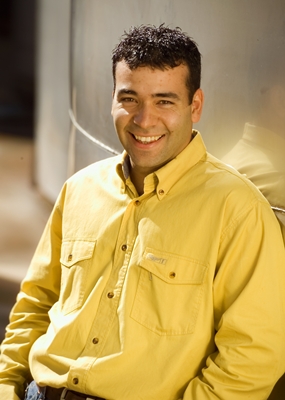Among the enormous variety of white-wine grapes, there are five that stand above the rest. Chardonnay and Riesling are the top dogs, followed (in no particular order) by Chenin Blanc, Sémillon and Sauvignon Blanc. The name Sauvignon comes from the French word “sauvage” meaning “wild”. It’s often described as the total opposite to Chardonnay. The brilliant wine writer Karen MacNeil once commented that “If Chardonnay is Marilyn Monroe, then Sauvignon Blanc is Jamie Lee Curtis.”
You may recall that Jamie Lee Curtis made her debut in the horror movie Halloween, and was subsequently cast in several other horror flicks, earning her the dubious title of “scream queen”.
The Sauvignon Blanc originally hails from France’s Loire Valley and some of the best still come from there. Sauvignon’s lean, tart herbal qualities are often tamed by blending the wine with Sémillon, a somewhat softer wine which has found a new home in Australia.
“Rumours” Sémillon-Sauvignon Blanc 2011 (white) Australia. (Foodland, Bt. 395)
Warburn’s winemaking traditions began in Italy many years ago and Warburn Estate is now a third generation family business located at the centre of Riverina in New South Wales. Warburn has more than 1000 hectares under vines and tank storage for 35 million litres of wine.
 Warburn’s chief wine maker, Carmelo D’Aquino.
Warburn’s chief wine maker, Carmelo D’Aquino.
Rumours is one of many brands produced by Warburn Estate. The company also produces several other well-known lines that you’ve probably seen, notably Bushman’s Gully, Aspen Estate and Gossips. The Rumours range includes three other very popular varietals but I shall leave you to guess what they are. Here’s a clue; two of the grape varieties begin with the letter “C” and one begins with the letter “S”. You don’t need to be much of an expert to work that out.
Anyway, this is a blend of Sémillon (say-MEE-yohn) and Sauvignon Blanc (SOH-vee-nyawn blahn) and the wine is an extremely pale straw colour with a pronounced greenish hue. There are delicate aromas of fresh lemon, lemongrass, passion fruit and guava with a hint of dry herbs in the background.
The taste came as something of a surprise, being much more lively and crisp than I expected, partly because the freshness has been preserved by maturing the wine in stainless steel tanks. It’s very light-bodied with an attractive soft mouth-feel; the fruit is well forward and there’s a refreshing acidity. With a very dry citrus finish, its fresh bright quality would make this wine ideal for light chicken dishes or seafood. Although it’s only 11% alcohol, the wine’s zestiness would probably make it a good partner for many Thai or Chinese dishes too, but serve it as cold as you dare.
“Alma de Chile” Sauvignon Blanc 2009 (white) Chile (Villa, Bt. 339)
Produced from grapes grown near the foothills of the Andes Mountains, Alma de Chile wines have acquired an enviable reputation. By lowering yields and harvesting riper grapes, the company has produced wines that are well structured and show fine balance. Several of their wines have been awarded gold, silver and bronze medals in European competitions.
Alma de Chile means “The Soul of Chile” and this lovely light-gold wine has a warm honey-like floral aroma of peaches, against a background of sweet tropical fruit. There’s a subtle hint of oranges too. With a lively taste of peaches and melons up front, it has a spritzy acidity and a long citrus finish. It’s quite light-bodied with a pleasing dash of acidity. This wine has the typical zesty quality of Sauvignon Blanc and makes a pleasing easy-drinker. At 12.5% alcohol, it would make a good partner for fish or light chicken dishes.
You’d probably expect that a Sauvignon Blanc blended with a Sémillon would be a softer wine than an unblended Sauvignon. Tasting these two wines side by side, it transpires that the opposite is true. While the Rumours is typically sharp and spiky, the Alma de Chile is somewhat softer but of course, it’s two years older.
Incidentally, I discovered that the word “feisty” originates from a combination of the Old English word fyst (evidently meaning to “to break wind”) and the German fist – a small excitable dog.




